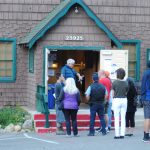By Jared Dillon
Idyll Awhile beer expert
The style of Christmas ale can be classified as a unique one. Even to name the style after Christmas is a misnomer. Historically, cultures around the world have created some form of fermented beverage to celebrate the change from autumn to winter. Many civilizations around the world have celebrations or holidays surrounding the winter solstice. Seasons are changing and many primitive cultures saw this as an important transitional period of life.
Even today, many cultures see the winter solstice as an ending of the year and a transition to a new time. Interestingly enough, primitive cultures preferred to produce beers during this time that were very strong in terms of alcohol content. A wide variety of European strong ales we now consider common — like Germany’s Doppelbocks or Belgium’s Quadrupel ales — find their roots firmly attached to solstice celebrations, specifically Christmas.
Trying to explain the “Christmas” ale style is very difficult. Typically the guidelines of holiday ales are that they tend to be both strong in flavor and alcohol. They also historically are flavored with seasonal ingredients. Belgian-style Christmas ales are notorious for their strong cinnamon, nutmeg and anise flavors. German-style Christmas ales are typically strong lagers with rich caramel notes that lend themselves perfectly to cold winter evenings.
Samichlaus is a personal favorite of my father and mine. Samichlaus at one point was considered the strongest beer in the world. Topping off around 14 percent ABV, the beer can be aged for decades and its flavors have more in common with a brandy than a beer.
When we start to examine the American Christmas-style ale we see an intense variety of flavors and even styles. Anchor Brewing’s Christmas Ale is redefined every year, but lends itself toward the style of Anchor Steam with more pronounced holiday spices. Sierra Nevada’s Celebration Ale is a dry-hopped pale ale that embraces the spicy nature of holiday ales by adding a variety of hops to mimic those spicy characteristics.
Regardless, we must embrace the sentiment for holiday in these ales. Historically, widespread festivals served this type of ale as a means of celebration. The act of beer is ritual, much like the act of celebration. And whether it is a Belgian, German or American ale, they should be enjoyed with friends and family. All of these beers historic or not were brewed in the hopes of bringing about cheer and good wishes. Happy holidays from Idyll Awhile.










